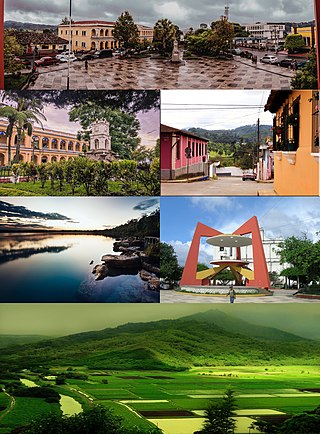
Cobán,fully Santo Domingo de Cobán,is the capital of the department of Alta Verapaz in central Guatemala. It also serves as the administrative center for the surrounding Cobán municipality. It is located 219 km from Guatemala City.

The governor of the State of Yucatan is the head of the executive branch of the Mexican state of Yucatán,elected to a six-year-term and not eligible for reelection. The figure of the governor is established on the Constitution of the State of Yucatan on its Title Fifth. The term of the Governor begins on October 1 of the year of the election and finishes September 30,six years later.

Juan de Zumárraga,OFM was a Spanish Basque Franciscan prelate and the first Bishop of Mexico. He was also the region's first inquisitor. He wrote Doctrina breve,the first book published in the Western Hemisphere by a European,printed in Mexico City in 1539.
Tactic is a town and a municipality in the Guatemalan department of Alta Verapaz. It is situated at 1,465 m above sea level. The municipality has a population of 38,052 and covers an area of 102 km². At the 2018 census,the population of the Tactic town was 15,213. The languages spoken in Tactic are predominantly Spanish,Poqomchiʼ,and Q'eqchi'.
Alonso de Estrada was a colonial official in New Spain during the period of Hernán Cortés' government,and before the appointment of the first viceroy. He was a member of the triumvirates that governed the colony for several short periods between 1524 and 1528,in the absence of Cortés.
Francisco Ceinos was one of five oidores (judges) of the second Real Audiencia of Mexico. This group governed the colonies of New Spain from January 10,1515 to April 16,1535. Ceinos was also president of the audiencias that served as interim governments of New Spain from 1564 to 1566 and from approximately July 1568 to November of that year.
Diego Delgadillo was a judge of the first Real Audiencia of Mexico,which took control of the governance of New Spain from the conquistadors from December 9,1528 to January 9,1531.
Juan Ortiz de Matienzo was a Spanish colonial judge and an original member of the first Real Audiencia of Santo Domingo,in 1512. From December 9,1528 until January 9,1531,he was a member of the first Real Audiencia of Mexico,which took over the governance of New Spain from the conquistadors.
Juan de Salmerón was a Spanish colonial official New Spain,and an oidor (judge) of the second Real Audiencia of Mexico,which governed the colony from January 10,1531 until April 16,1534. On the latter date,the government was turned over to Antonio de Mendoza,the first Viceroy of New Spain. Along with Fray Toribio de Benavente Motolinia he built the first European settlement at Puebla,Puebla.

Juan Vázquez de Coronado y Anaya was a Spanish conquistador,remembered especially for his role in the colonization of Costa Rica,in Central America,where he gained a reputation for fairness,effective administration,and good relationships with the native population. He was a nephew of Francisco Vázquez de Coronado y Luján,who explored the southwestern United States between 1540 and 1542.

The Province of Yucatán,or the Captaincy General,Governorate,Intendancy,or Kingdom of Yucatán,was a first order administrative subdivision of the Viceroyalty of New Spain in the Yucatán Peninsula.
Alonso de Reinoso (1518–1567) was a Spanish Conquistador in Honduras,Mexico,Peru and Chile. He was born in Torrijos Toledo,Spain in 1518. He was married to Catalina Flores de Riofrío before he came to the Americas in 1535.

Francisco Marroquín was the first bishop of Guatemala,translator of Central American languages and provisional Governor of Guatemala.
Alonso Valiente was a Spanish conquistador. He was Hernán Cortés' cousin and secretary. He was one of the first governors of Mexico City. He was also the first encomendero of Tecamachalco,and he contributed to found Puebla de los Ángeles,where he also served as mayor.
The Royal Audience and Chancery of Panama in Tierra Firme was a governing body and superior court in the New World empire of Spain. The Audiencia of Panama was the third American audiencia after the ones of Santo Domingo and Mexico. It existed three times under various guises since it first creation in 1538 until its ultimate abolition in 1751.
The Real Audiencia of Santiago de Guatemala,simply known as the Audiencia of Guatemala or the Audiencia of Los Confines,was a Real Audiencia in the Imperial Spanish territory in Central America known as the Captaincy General of Guatemala (1609-1821). The Audiencia's presiding officer,the president,was the head of the government of the area. The Audiencia was initially created by decrees of November 20,1542 and September 13,1543,and had its seat in Antigua Guatemala.

The Spanish conquest of Honduras was a 16th-century conflict during the Spanish colonization of the Americas in which the territory that now comprises the Republic of Honduras,one of the seven states of Central America,was incorporated into the Spanish Empire. In 1502,the territory was claimed for the king of Spain by Christopher Columbus on his fourth and final trip to the New World. The territory that now comprises Honduras was inhabited by a mix of indigenous peoples straddling a transitional cultural zone between Mesoamerica to the northwest,and the Intermediate Area to the southeast. Indigenous groups included Maya,Lenca,Pech,Miskitu,Mayangna (Sumu),Jicaque,Pipil and Chorotega. Two indigenous leaders are particularly notable for their resistance against the Spanish;the Maya leader Sicumba,and the Lenca ruler referred to as Lempira.






